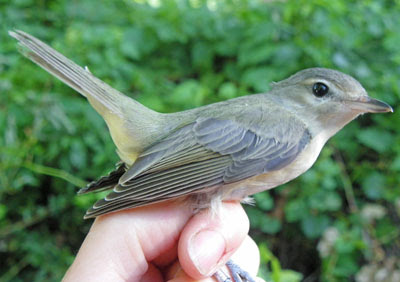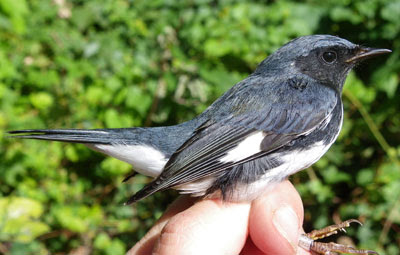The first week of Migration Songbird Monitoring produced a few exciting highlights for the week. These included our first Yellow-billed Cuckoo for the year. We heard them occasionally during spring and summer but none were slow enough to get into the nets to be banded. Another highlight was the 18 warbler species captured in the first week! These included: Tennessee, Nashville, Chestnut-sided, Magnolia, Black-throated Blue, Black-throated Green, Bay-breasted, Blackpoll, Black-and-white, American Redstart, Prothonotary, Ovenbird, Northern Waterthrush, Connecticut, Mourning, Common Yellowthroat, Wilson’s, and Canada. It's worth noting that there has not been a Yellow Warbler (YWAR) seen or heard on the research site since mid-August. It appears that the resident YWARs have left the area.
Here are some pictures of a few early migrating warblers just in case you do not have a chance to get out and enjoy them:
Wilson's Warbler (WIWA)

Chestnut-sided Warbler (CSWA)
A weak front came through on Thursday and turned the winds to the NW which produced a small movement of birds on Friday and Saturday. The coming week looks to be good after Thursday when another front is slated to come through and temps are to drop to the low 80’s.
We were able to set up the five beach nets in addition to the main migration station nets this week. As usual, the beach nets caught higher numbers of Warbling Vireos (WAVI) than the nets inside the dike at the main station. Twelve out of the 14 WAVIs captured were caught in the five beach nets versus two in the 23 inside nets. This is a species that appears to be favoring habitats immediately along the lake shore instead of the larger older ridge habitat just a few yards inside the dike.
Warbling Vireo
Another highlight Saturday was capturing two Connecticut Warblers (CONW). 
One was an adult male with its gray head and distinctive eye ring that really does stand out and go “Boing!" The other is a hatching year bird of unknown sex with a distinctive eye ring that looks similar to what a female CONW eye ring looks like. Hatching year birds generally can't be sexed with certainty. Even so, these are gorgeous birds no matter what their plumage!
Since Saturday was an exceptional day for warblers, I thought it would be great to take a group photo of eye ring warblers.
 The only one I wanted that was missing was the Chestnut-sided. Look at the photo of the CSWA above and you'll understand why it would have fit into the group photo. Can you identify all the eye ring birds? (Answer below).
The only one I wanted that was missing was the Chestnut-sided. Look at the photo of the CSWA above and you'll understand why it would have fit into the group photo. Can you identify all the eye ring birds? (Answer below). Three other favorite birds of the week I would like to share are these:
Tennessee Warbler
Just look at the green on this bird! The TEWA is the only warbler I know that has this chartreuse green coloring. Note the white undertail coverts which distinguishes TEWA from its cousin the Orange-crowned Warbler (OCWA), which has yellow undertail coverts.
This bird was a perfect example of an adult female Black-throated Green Warbler (BTNW).

Here is the male warbler that remains black, blue, and white in every plumage, the Black-throated Blue Warbler. 
Isn't he a handsome bird?! This particular bird is a hatching-year with his green-edged primary coverts. Otherwise he looks like an adult male in coloration.
Enjoy the early fall migrating birds. There are still some Baltimore Orioles (BAOR) singing as well as flycatchers and you may catch a glimpse of the last of the golden Prothonotary Warblers before they head south!
Answer to the eye ring bird quiz: From left to right: Magnolia Warbler (MAWA), Nashville Warbler (NAWA), Ovenbird (OVEN), and Connecticut Warbler (CONW).



















